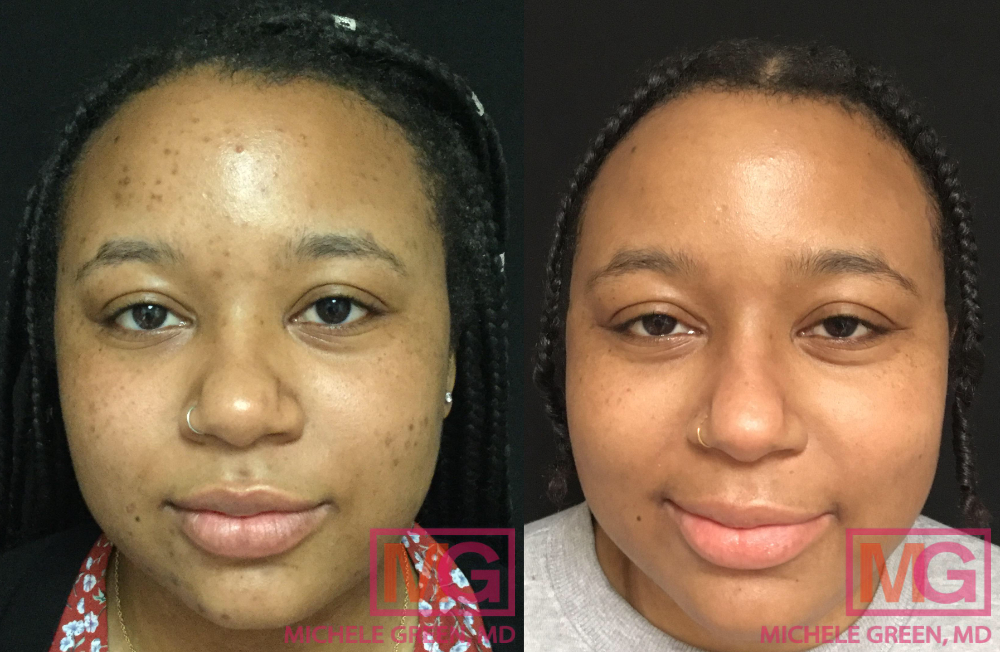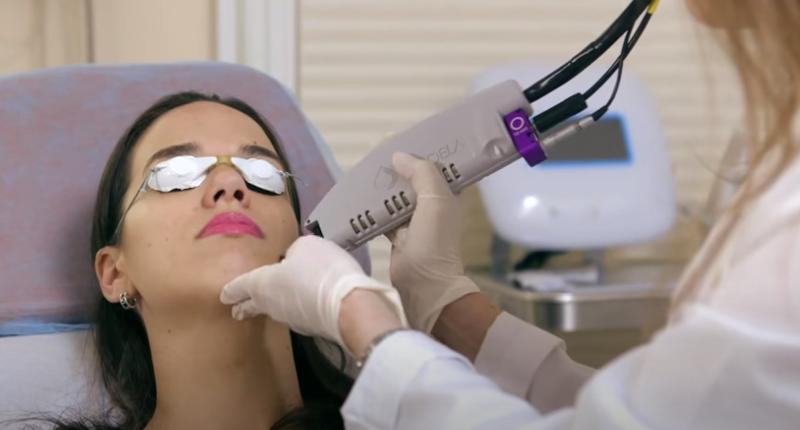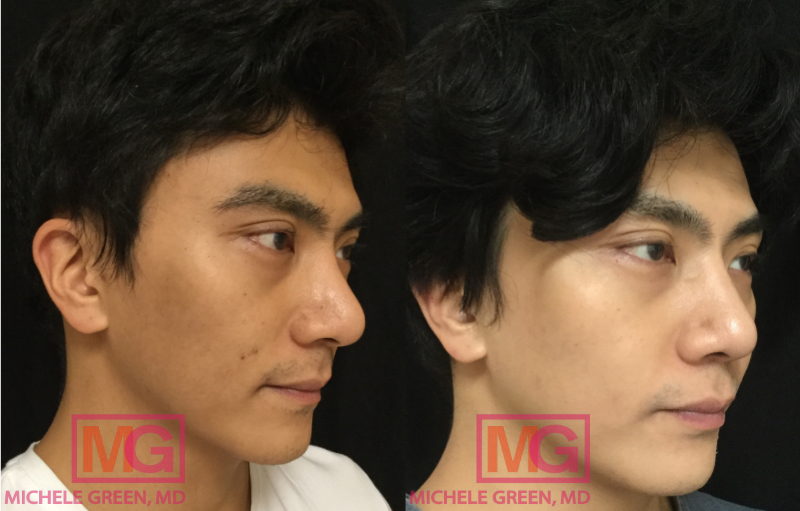Do Tanning Beds Help Acne?
Since acne breakouts are one of the most universal skin conditions for all of our patients, we often find that patients have developed creative solutions to clear up acne. One common discovery that people from high school through adulthood find is the effect that sun exposure can have on the skin. Particularly in our current society, an overly-tanned appearance has become a popular false equivalency for healthy skin. Over the past decade, a lot of research has been done into inaccurate claims that tanning salons have about offering eczema, psoriasis, or acne treatment through the use of ultraviolet rays.
As it turns out, the UV rays from tanning beds do much more harm than good. Though a beach vacation tan can help to camouflage blemishes, pimples, or acne scars on the surface of the skin, too much UV light – from either a tanning booth or excessive sun exposure – can increase risk of skin cancer and premature aging, and cause an overall increase in acne breakouts. Tanning bed exposure ultimately causes a great deal of damage to your skin, which is a far cry from the healthy, glowing skin that we all crave.
If you’re frustrated by the appearance of acne on the surface the skin, board-certified dermatologist Dr. Michele Green is here to help. Dr. Green is an expert in acne treatment and knows the best ways to ensure healthy, acne-free skin for the long term. When you work with Dr. Green, she’ll be able to develop a custom treatment plan for you that relies on a combination of acne medications, in-office treatments, and skin care routines that can all help to treat active acne lesions, acne scars, and prevent acne breakouts from returning.

Why does tanning make my skin “better”?
Many patients have seen it: a summer tan has appeared, and patients feel that their zits are smaller, their skin looks firmer and smoother, and they observe a “glow”. However, the look or feel of a tan is often misleading. Spending too much time in the sun without appropriate levels of SPF sunscreen or high-SPF moisturizers can lead to hugely negative aftereffects, including premature aging of the skin, the development of fine lines and wrinkles, and an increased risk of skin cancer. Furthermore, excess sun exposure is one of the most common causes of dark spots or hyperpigmentation, sun spots, and melasma on the skin, including among patients with darker skin types.
Another important aspect of acne and sun protection is the use of acne medications and topical treatments that can make the skin extremely sensitive to ultraviolet rays. Patients who use benzoyl peroxide, retinoids, adapalene gel, or salicylic acid need to be very careful about protecting their skin from sun damage. In order to limit premature aging of the skin, as well as protect the skin from further acne breakouts, Dr. Green always recommends patients use a high-SPF sunscreen whenever out in the sun, such as MGSKINLABs Hydrating Sunscreen.
Can the tanning bed help acne?
If you’re curious, can tanning beds help acne?, the answer is, unfortunately, no. Tanning beds use intensive UV rays to darken the color of the skin, and this method is linked to skin cancers, including melanoma. As the majority of skin cancer cases are caused by sun damage due to ultraviolet rays, tanning booths often compound this risk by using direct ultraviolet wavelengths to tan the skin. Additionally, the only effect a tanning salon can have on acne is to darken the skin, thus making blemishes and pimples become less obvious on the surface of the skin. According to research by the American Academy of Dermatology, tanning beds do not help acne.
Do tanning beds help clear acne?
As we’ve discussed, tanning beds do not help to treat acne and, what’s more, both outdoor and indoor tanning can make acne breakouts worse. Spending hours in the sun or in a tanning booth typically dries out the skin, which triggers greater oil production from the sebaceous glands of the body. This in turn can lead to a larger amount of acne breakouts, rather than helping to treat blemishes. Additionally, dry skin or sunburn can lead to a larger amount of dead skin cells on the surface of the skin, which is one of the primary causes for increased pimples.
Do sunbeds help acne scarring?
Many tanning salons suggest that sunbeds or tanning beds can help to reduce the appearance of acne scarring. This is completely false and, to make matters worse, tanning beds can actively damage and worsen skin affected by acne scars! When the skin works to heal an acne scar, collagen and elastin fibers are particularly vulnerable to UV rays, and tanning can limit the body’s natural ability to heal the skin.

Do tanning beds help acne scars?
When it comes to whether tanning beds can help acne scarring, the answer is that they can in fact make acne scars worse. Tanning beds tend to dry out the skin, and can damage collagen and elastin fibers in the skin working to heal acne scars on the surface of the skin. For this reason, a tanning booth or extreme sun exposure can not only prevent acne scars from healing, but can also make an acne scar appear darker, as the damaged skin cells are further injured by direct UV rays.
Does tanning cover acne scars?
Though excessive tanning might temporarily reduce the appearance of acne scars, the damage to acne scars will be immediately apparent once the tan fades; any “covering up” will dissipate as quickly as a strong tan. Additionally, the chances of a tanning booth creating a tan that reduces the appearance of an acne scar–rather than making the scar appear darker on the surface of the skin–is slim at best. The tanning booth experience will damage the skin cells of the acne scar, and any slight chance of improvement in the “look” of the acne scar is not worth the risk.
Vitamin D: Does the sun kill acne?
Many tanning salons and other proponents of tanning lotions argue that Vitamin D absorption is vital to healthy skin care, and that the sun’s rays can eliminate acne-causing bacteria on the surface of the skin. However, what the tanning industry fails to mention is that Vitamin D needs can be met by a diet of Vitamin D-rich foods, as well as by exposing the skin to sunlight for about 5-20 minute sessions twice a week, which is way less than the time required to get a tan. By eating foods like salmon, herring, tuna, egg yolks, mushrooms, and fortified milks and cereals, patients can enjoy the benefits of Vitamin D to the skin without increasing the risk of dark spots or skin cancer.
What really helps to treat acne
When it comes to treating active acne breakouts, reducing the appearance of acne scars, and preventing blemishes from returning, there are medically founded, FDA-approved treatments that can make a difference. From blue light therapy to acne facials to topical treatments, Dr. Green offers the highest standard of acne care in the world of dermatology.

28 yr old female – Accutane and dark acne spot treatment
Skincare Solutions
When it comes to treating acne, one of the most important factors to consider is a daily skincare routine that can safely and effectively reduce the development of acne lesions. A gentle exfoliating or antibacterial cleanser that relies on active ingredients like salicylic acid, glycolic acid, benzoyl peroxide, or sodium sulfacetamide can help to boost cell turnover and remove dead skin cells from the surface of the skin. Additionally, non-comedogenic moisturizer is key in helping to soothe the skin without risking further breakouts.
When it comes to targeted skincare treatments, Dr. Green has developed her own acne-fighting skincare routine, MGSKINLABS Three Step At Home Acne Treatment. This routine combines a pore minimizing cleanser with glycolic acid and salicylic acid retexturing pads, as well as a benzoyl peroxide acne spot treatment to both target active acne lesions and prevent the development of further acne breakouts.
Topical Acne Medications
When it comes to the treatment of acne lesions, there are a variety of over-the-counter and prescriptions topical treatments that can help to keep acne at bay. Benzoyl Peroxide, retinoids, and topical antibiotics can all help to treat acne at its source. Additionally, adapalene gel combinations, such as Differing Gel or Epiduo Forte (a combination of benzoyl peroxide and adapalene gel) can work incredibly well as spot treatments for acne breakouts. However, it’s important to note that most of these treatment make the skin sensitive to direct sunlight, making high-SPF sunscreens and moisturizers all the more important in a patient’s skincare routine.
Oral Acne Medications
For many patients, oral antibiotics like Doxycycline, Minocycline, and Tetracycline can help to treat acne blemishes, as well as inflammation caused by acne, and rosacea. Additionally, certain contraceptives or birth control pills can help to reduce the appearance of acne on the skin by regulating a patient’s hormonal cycle, thus reducing the development of hormonal acne. For patients with an underlying hormonal imbalance, Spironolactone may help to treat acne breakouts by decreasing the amount of androgen hormones in the body. Lastly, for patients who suffer from painful cystic acne or recalcitrant acne, Isotretinoin, popularly known as Accutane®, can be a total game-changer. For patients who take Isotretinoin, proper sun protection is of the utmost importance, as it can make patients highly susceptible to sunburn.
Laser Acne Treatment
Laser acne treatments can be a wonderful way to reduce the appearance of active acne lesions, as well as to help improve the appearance of acne scars. The VBeam® laser is a popular option for patients dealing with redness and swelling due to acne, and can also help to treat rosacea and broken blood vessels. Additionally, Blue and Red Light Therapy uses LED-based wavelengths to kill bacteria on the surface of the skin and reduce the size of the sebaceous glands, thus preventing future acne flare-ups. Lastly, photodynamic therapy uses blue light to eliminate acne-causing bacteria and reduce the appearance of inflammation on the surface of the skin. Each of these laser treatments require careful sun avoidance immediately post-treatment for optimal results.

Acne Facials and Hydrafacials
Once of the most popular in-office treatments for acne is an in-office facial treatment. Acne facials rely on a surface cleansing of the skin, followed by a light glycolic acid treatment to exfoliate the skin and help diminish the appearance of acne scar tissue. The third step of the acne facial is a steam and extraction process used to eliminate any active acne lesions. After this, a purifying mask is applied to sooth the skin, and the final step relies on the application of oxygen to naturally moisturize the skin and rejuvenate skin cells.
The Hydrafacial® is another excellent facial option for patients dealing with acne breakouts. The Hydrafacial is a medical-grade treatment that uses cleansing, exfoliating, and infusing of intensive serums to help clear out and hydrate pores. It’s a gentle facial approach that can be used on a wide variety of age groups and skin types, and is safe to use on sensitive skin. Lastly, the Hydrafacial combines the exfoliation of the skin with the removal of dead skin cells in order to reduce cell turnover and allow the skin to fully absorb revitalizing nutrients such as Vitamin E and other growth factors. The Hydrafacial can also be combined with blue and red light therapy to reduce the appearance of inflammation on the skin and eliminate acne breakouts.

Before and After Chemical Peels – 4 sessions in 6 months
Chemical Peels
Chemical peels are a popular approach to the removal of active acne breakouts as well as acne scarring. Through the use of glycolic acid or Trichloroacetic acid chemical peels, Dr. Green is able to exfoliate dead skin cells and actively treat acne while rejuvenating the skin. Additionally, Dr. Green can tailor chemical peels to best meet the needs of each individual patient, aiding in the treatment of acne and acne scars.
If you’re frustrated with acne breakouts or acne scars, there are solutions that won’t put you at risk for skin cancer or lead to premature aging. Dr. Michele Green will provide you with the best medical and cosmetic treatments at her boutique NYC office. With over 25 years of experience as a cosmetic dermatologist in New York, Dr. Green is consistently voted one of the best dermatologists in NYC by the New York Times, Super Doctors, and New York Magazine. Please contact our NYC based office today or call 212-535-3088 to learn more about the best acne treatment plans for you.
 212-535-3088
212-535-3088